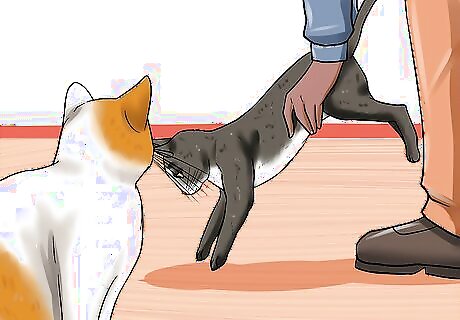
views
X
Expert Source
Francine MillerCertified Animal Behavior Counselor
Expert Interview. 10 September 2020.
When you have two or more cats in the same household, you should strive to establish and ensure a lasting friendship between them.
Introducing a New Cat Into the Household

Choose the best companion. You need to carefully consider things like the age, size, and personality of the new cat before deciding to bring it home. Ideally, choose a spayed or neutered new cat of the opposite sex that is younger and smaller than your existing cat. In addition, select a new cat who has a similar personality as your current cat.

Consider the new cat’s background. Take your time in getting to know the new cat before making any final adoption decisions. A cat’s background matters; stray cats tend to be territorial, competitive and aggressive, while an orphaned cat raised in a household is oftentimes appears more fearful and awkward, typically requires more time to adjust to their new life.T

Give the relationship time to grow. The normal adjustment period ranges from six to 12 weeks, but it can be longer when the matchup is less than ideal. If there are too many conflicting factors in the matchup, you risk the chance of the cats never forging a friendship, but becoming enemies instead.Take your time in finding the right match to lessen the potential for future problems.

Introduce the new cat from a distance. Cats naturally prefer to be alone and are not dependent on each other for things like hunting and socialization.Keep the new cat in a separate room for about one week so she can get used to her new environment and so both cats can become familiar with the other cat’s scent and sounds. Be sure the new cat has plenty of food and water. You’ll also want to surround him with other things to help him feel at home, such as a litter box, a place to hide, a scratching post, and toys to play with.Make sure you are spending this time to bond with the new cat. You can bond with him by playing games, feeding him treats by hand, and cuddling and grooming him. During this period of isolation, be sure to have the newcomer vaccinated and tested for parasites and diseases by a veterinarian.

Allow the new cat to explore the house. Once the initial one week period of isolation is over, the new cat is successfully using the litter box, and appears comfortable in his new environment, allow him to explore the rest of the house. However, only do so after placing your existing cat in another room; it is still too soon to bring the two cats together. This exploring opportunity will allow the new cat to become familiar with the existing cat’s smell. If you prefer, you can exchange the two cats’ bedding overnight. This too will allow the cats to become acquainted with each other’s smell.
Making the Initial Face-to-Face Introduction

Allow each cat to see each other without physical contact. You’ve finally reached the step where the two cats see each other in the flesh! This is an exciting turning point, however, this initial introduction must be done slowly and carefully. Introduce the cats together by placing a barrier between the two of them so there is no way they can come in full body contact. For instance, you might place them in adjacent rooms with the door shut. Be sure that you are home to monitor the two cats’ interaction regardless of which barrier method you choose. Do not let the cats interact until they both appear fairly calm around each other. Mild aggressive behavior, such as hissing and then walking away, can be normal behavior for cats who have been apart for several weeks. Aggression is one way that cats communicate with one another, and mild aggression is usually okay as long as they are not fighting.

Let the cats meet face-to-face. It is now time to remove all physical barriers and allow the cats to have their first face-to-face meeting. Remove the new cat from her cage, or remove the gate or door barrier that was used to separate them. Stand close by as the two cats come towards each other. Be aware that the existing cat may stalk and chase the new cat, or the newcomer may do the same if the existing comes and enters the isolation room. Don’t worry; this is normal. Just be sure to supervise both cats throughout the interaction. Avoid holding either cat in your arms during this introduction . You could end up scratched or bitten if one or both of them becomes aggressive towards each other.If your cats do get into a fight, do not try to reach in and break it up with your bare hands. Instead, grab a nearby squirt bottle, water gun, water hose, or water bottle. Then proceed to dose the cats with water; this will probably end the fight within a few seconds. Remember that this process may take quite some time. It could just a few days if you’re introducing two kittens to each other and potentially several months when introducing two adult cats.

Watch for signs of stress. Cats can become stressed during the introductory period. Make sure you pay attention for behavior that could indicate that either cat is street. Stress signs include whimpering, hiding, vomiting, excessive grooming/eating/drinking, spraying, and urinating/defecating in inappropriate places.
Reestablishing a Broken Friendship

Keep them separate. Like people, cats sometimes need an extended break from each other. Keep the cats separate for several days or weeks. Make sure you provide them with the necessary things to keep them comfortable like their bed, food bowl and litter boxes. Have the cats switch rooms every day so they have the opportunity to smell the other’s scent.

Make the full acquaintance once they seem comfortable. Once several days have passed, crack the door open about one inch to see how they both respond. If the response is calm, open the door a little more, continuing this process until they are back in each other’s presence. However, if they react by showing aggressive, return them back to separation and repeat the reestablishing friendship routine over again. You might find that rubbing a little tuna juice on the cats’ body and head helpful, as this will likely cause them to become distracted with grooming themselves, which will lessen their focus on each other.
Helping Cats Who Never Got Along

Provide isolation. You’ll need to isolate the cats as described above but for a longer time frame. You’ll also need to reintroduce them to each other at a more gradual pace, which can range from several days to a few weeks.

Reintroduce the cats to each other. You’ll want to do a daily reintroduction to cats with an already established history of not getting along. Complete this by slowly moving the cats closer to another each day while you provide close supervision. Keeping both cats distracted with food or toys can always help the transition. Keep the sessions brief, and keep them separate between the reintroduction sessions to improve chances of success. If the reintroduction sessions prove to be ineffective, consult a veterinarian to determine if behavioral medication should be considered. Behavioral medication such as benzodiazepines, tricyclic antidepressants, and selective serotonin inhibitors can be helpful in modifying aggressive behavior in cats.

Be patient with relinquishing supervision. You’ve been a patient and attentive cat parent throughout this entire process. However, you must keep the new cat in the isolated room for the first few weeks of the reintroduction process. After that, start off by providing the cats with short periods of unsupervised access, then gradually increase their alone time together. Do not leave the cats alone until you are confident that neither cat will display aggressive behavior toward the other. In addition, you can leave the cats alone once they are peacefully eating and playing within a couple of feet away from each other.



















Comments
0 comment